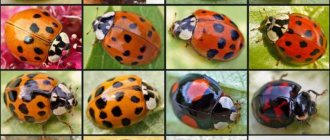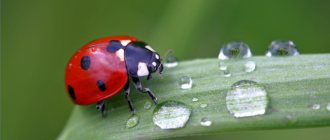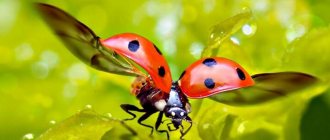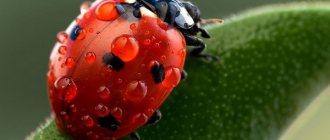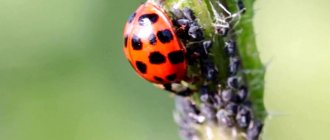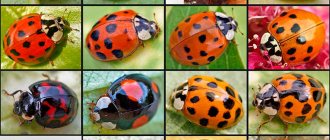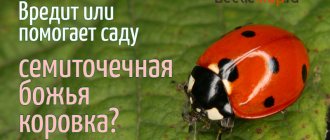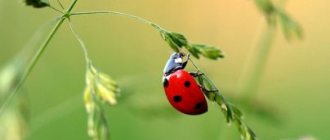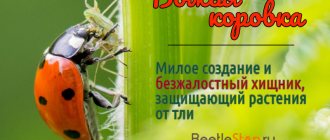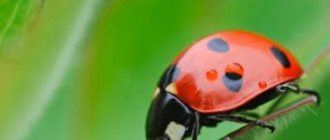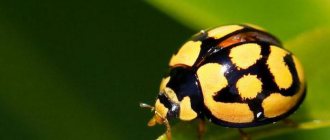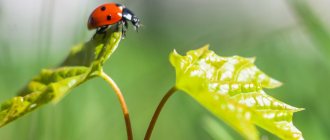- September 15, 2018
- Tips for tourists
- Anisimova Svetlana
This small cute bug, which lives throughout the Earth, is called “ladybug” in Russia. Why did they call him that? Despite the fact that its name sounds different in other countries, it is necessarily associated with God or the Mother of God. Its simple bright coloring attracts the human eye. Children especially love him. It is not for nothing that toys depicting this beetle are made for the little ones.
Ladybug beetle. Why is it called that?
In Russia everywhere, this little bug is associated with many beliefs and legends that explain the name. If a “ladybug” lands on you, then you should not be afraid. It was believed that these bugs live in the sky and are harbingers of good events. They fulfill the mission of God's messengers, and therefore require respectful treatment. They cannot be offended, much less killed, as this can bring misfortune.
There is another belief why the “ladybug” is called “ladybug”. If you want to convey your message to heaven, then during the time that the “ladybug” is sitting on your right hand, where it must be transplanted if you find it on yourself, and has not flown away, tell her about your request or dream. She will definitely pass it on to God and perhaps your wish will be fulfilled. It is interesting that similar legends exist among almost all European peoples, so it is not surprising why the “ladybug” is called that. She is treated with sympathy and is certainly associated in some countries with God, in others with the Mother of God.
The benefits and harms of ladybugs
The gluttony of predatory ladybugs and their larvae has long been beneficial to gardens, vegetable gardens and crops of cultivated plants in many countries around the world. If a ladybug larva is capable of destroying about 50 aphids per day, then an adult ladybug can eat up to 100 aphids per day. To clear agricultural land of pests, populations of ladybugs are specially bred at special enterprises and, with the help of aviation, they are sprayed over fields and plantations infested with pests.
However, herbivorous species of beetles, living mainly in the subtropical and tropical regions of South and Southeast Asia, are capable of causing great damage to agricultural crops. In Russia, there are also several species of ladybugs that destroy potatoes, tomatoes, cucumbers, and sugar beets.
These insects are quite voracious. Thanks to this property, it is possible to maintain the full development of vegetable gardens and orchards and protect them from aphid invasion. Just one ladybug larva per day can destroy more than 30 aphids. An adult bug can easily cope with a hundred or more pests.
Ladybugs, which prefer plant foods, are not at all harmless. They live mainly in Latin America, as well as in some regions of South Asia. Such insects cause enormous damage to agricultural land. Such ladybugs are capable of destroying tomatoes, potatoes, cucumbers, and beets.
There's a ladybug at home - what to feed it?
If you find a live ladybug in your apartment, help it survive until spring. The best way is to take it out of the house, but not to throw it into the snow, but to find a good shelter. A barn or garage is ideal for this purpose, where they can overwinter without any problems. Do not do this in severe frost, so that the temperature difference for the insect is not too strong.
Keeping an insect in the freezer until spring is not the best idea; the ladybug simply will not survive.
If you want to try to keep a ladybug alive at home, you need to know what to feed it and how to properly maintain it. Take any container, arrange a floor at its bottom from leaves, branches, sticks and transfer the ladybug there. We also recommend that in order to create optimal living conditions for the insect, put more straw and dry leaves into the container, loosely mixing them together, so that artificial crevices are created, which ladybugs so love to use as their lair. It is possible to use corn tops for shelter in a jar; it will perfectly close the insect’s home from prying eyes. At home, ladybugs are fed with sweet sugar water or honey; you can pour these mixtures into the cap of a plastic bottle. This food is a treat for the ladybug. In addition to sweet water, these beetles are fed raisins and pieces of ripe apples. Just like any pet, a ladybug needs some water.
Think twice before you decide to keep a ladybug at home, because it may not survive until spring and this will not necessarily be your fault; the lifespan of a ladybug is about 2 months.
How do insects winter at home, why are they bred?
However, nothing stops some exotic lovers. They are not only ready to shelter a random insect for the winter, but also specifically breed them. The industrial cultivation of ladybugs is an amazing fact in the history of the use of insects in the fight against other insects.
To breed these bugs at home you may need:
- container;
- bottle caps;
- grass and leaves;
- stones;
- sticks;
- sugar or honey
People do this for a specific purpose, so that they can then release such a “herd” in their garden or sell it to gardeners. For comfortable conditions in the home, ladybugs are planted with plants that specifically infect aphids. This is necessary so that in the wild they immediately find themselves in their natural habitat; knew how to hunt and be nocturnal.
In addition to gardeners, you can offer such a product to farmers and agronomists; they will send him to the fields. Consider selling online: there are also people interested on the World Wide Web.
Ladybugs are kept in small containers with holes through which the feeding process takes place. The diet includes sugar and yeast, and at times raisins and apple slices.
In many countries they believe that the ladybug is a symbol of good luck, so these insects are carefully protected. The ladybug was depicted on items of clothing and jewelry. This served as a kind of amulet.
In order for the cultivation of ladybugs to be successful, it is important to collect as much information as possible about them, taking into account their behavior and reproduction characteristics.
Here are just a few points.
- It is not recommended to keep insects in glass jars: they quickly overheat in them and can even get burned.
- The bug is fed twice a day; Don't give him large amounts of food at one time.
- You should be careful when picking up a cow in your hand. The finger should touch the surface on which the insect is sitting. The bug will climb on it itself.
- The leaves in the cow's house need frequent renewal. Otherwise, mold may form and become a mortal danger for the insect.
- Do not forget that any living creature can be a source of disease. Therefore, after interacting with a ladybug, you should always wash your hands. A simple manipulation will protect you from danger.
- Insects are counted not by number, but by weight. This is done because of their good mobility.
- You have enough time to acquire ladybugs - from early spring to the end of summer.
- They are collected mechanically. To do this, they go to the edge of the forest or into a ravine and look for spotted bugs on plants such as tansy, daisy, yarrow or dill. You can also look in a field with oats or buckwheat.
- In hot weather, beetles tend to be more active. Then the house with insects needs to be moved to where it is cooler; this will calm them down. The cows will stop flying and start mating.
The ladybug is one of the few insects that almost everyone loves. Children treat these bugs with special trepidation. However, few even adults can say exactly how long they live and what they eat.
"Ladybug" in Slavic mythology
It is well known that the ancient Slavs deified the nature that surrounded them. Therefore, one legend says that the Sun God Perun, angry with his wife for betrayal, punished her by turning her into a red bug. But even after this, the anger was so great that he could not calm down and began to throw fiery arrows after the flying beetle. Their sparks left black round marks on the red wings.
But the wife of God Perun does not give up hope for her forgiveness. Therefore, he delivers messages from people to him and brings them good news from the ancient pagan God. This legend gives a clue why the "ladybug" was called "ladybug". Her appearance evokes positive emotions and trust in this lovely creature. She is not afraid to trust her with your dreams and desires.
Sent by God
But why did the ladybug become a “ladybug”? There are also several assumptions regarding this adjective. The main version is the fact that these insects are very useful, as they destroy aphids that are harmful to plants. A ladybug can eat about 200 insects per day. Thanks to this circumstance, apparently noticed by our ancestors, the harvest remains untouched. But it was precisely productivity that was considered in Rus' one of the factors of well-being. That’s why the cow was christened the ladybug, that is, sent by God himself to help.
It is interesting that in other languages the name of this insect is in one way or another also connected with its “divine” beginning. So, in Germany the ladybug is called the beetle of the Holy Virgin Mary, and in Argentina - the ladybug of St. Anthony.
According to another version, earlier in Rus', people, on the contrary, did not even realize that this insect was a real predator. Therefore, his harmless and even cheerful appearance prompted them to dub the insect a ladybug, by analogy with the man of God. This definition once applied to naive and trusting people.
Cute predator - “ladybug”
Many people imagine this beetle as a harmless herbivore, however, it is a real predator. Scientists have calculated that it eats 50 aphids per day, and its larva eats up to 800 during its development. This is a real aphid exterminator. Experienced gardeners know the damage this pest causes to many garden and garden plants.
The French breed these beetles on farms. You can actually buy them in special stores or even receive them cash on delivery by mail. A couple of ladybugs are enough to clean a rose bush. Why is this beetle called that? Maybe because it helps preserve the crops grown that feed people. He is valued in the same way as a cow, which is the breadwinner of an entire family. This is where the name comes from.
Nutrition
Most ladybugs are predators. Both larvae and adults feed on insects, including:
- aphid;
- caterpillars;
- scale insects;
- spider mites;
- eggs of butterflies and Colorado beetles;
- insect larvae.
Bugs do not hunt in the literal sense of the word. They do not ambush prey or set traps. The ladybug slowly crawls through the plant until it comes across something it can eat.
Representatives of several species eat exclusively plant foods: leaves, flowers and fruits, pollen, mushroom mycelium.
Do they feed in their natural environment in winter?
In winter, insects have no need for food: they either sleep or are in a state of suspended animation. Over the summer, sugar and glycerin manage to accumulate in their tissues. In order not to burst from the temperature drop when cold weather sets in, they have to remove a large amount of fluid from the body.
The ladybugs' task at the moment is to find warm places for wintering. A large number of insects can group together for these purposes in one place. Ladybugs usually prefer dry leaves, bark or window cracks as shelters.
But you should always remember: for such a small predator, a huge human hand poses a serious danger. Do not rush to completely plow the area, or spray the garden with poisons - you will lose your tiny helpers forever.
From the life of “ladybugs”
The food for these beetles is aphids, whose life period lasts from early spring until the first autumn frosts, as well as other small insects. The duration of activity of the “ladybug” lasts as long as there is food. In the fall, these beetles crawl under fallen leaves or stones and sleep until spring. Their lifespan depends on the availability of food and can range from several months to a year. But under favorable conditions it can be two years.
Young and old beetles can be distinguished. The fact is that young individuals have brightly colored hard wings. It fades with age. The bright color is not accidental and is intended to warn those who want to encroach on its life that it is poisonous. When meeting a predator, it secretes a kind of “milk” - an odorous and poisonous liquid. Here is another version of why the “ladybug” was called that.
Interestingly, birds do not hunt “ladies”; their main enemies are spiders and frogs, from which they try to fly away. When flying, the wings flap up to 85 beats per second.
What does the loaf have to do with it?
If you turn to the “Explanatory Dictionary of the Living Great Russian Language” authored by the famous ethnographer Vladimir Dahl, then the origin of the name of the insect can be associated with the word “loaf”. The fact is that in reality, many round-shaped objects received their names precisely thanks to the “loaf”, that is, their names are derived from this noun. For example, carpenters called this the rounded cut at the end of a log, and in some regions of Russia this is what they call the porcini mushroom. The mentioned insect also has a similar shape.
How did it happen that two such different words as “loaf” and “cow” turned out to be related? This secret is revealed by the “School Etymological Dictionary of the Russian Language,” edited by Shansky and Borovaya. According to the dictionary, in Ancient Rus' “loaf” was written with 2 “o” - “korovai”. But over time, akanye became entrenched in the language, and “loaf” acquired the spelling we are familiar with.
Variety of "ladybugs"
Above we talked about the “ladybug”, which has seven black dots on its red wings. It is this species that feeds on aphids and is widespread throughout Russia and Europe. But in nature, scientists have counted more than 400 species, among which there are real pests. Not all beetles included in this species are predators; there are those that feed on plant foods.
They may have different places of residence. Some live in trees, others in meadows on grass, shrubs, coastal grasses and reeds. Ladybugs are pests that live in subtropical Africa and Southeast Asia. In the Russian Far East, a serious danger is posed by the “ladybug”, which is colored yellow and has 28 black dots. It causes serious damage to potato and tomato crops.
So, of all the representatives of Coccinellidae, only the familiar and so cute red-orange bug with seven dots on its wings, which saves our gardens from aphids, ticks, fleas and scale insects, can be called a “ladybug”.
How do they reproduce and are born?
Insects reach sexual maturity at approximately 3–6 months of life (depending on the species).
Their mating season begins with the arrival of spring. The female produces a characteristic odor, thanks to which the future chosen one finds her. Next, mating occurs, and the female lays eggs (most often near colonies of parasites to provide food for the offspring).
The eggs are oval in shape with slightly tapered ends. Color - yellow-orange. In one clutch, the female manages to lay about 400 eggs. After 1–2 weeks, the larvae are born.
The ladybug goes through the following stages of development:
- The insect larva remains in this state for 1–2 months.
- The pupa attaches itself to the grass and spends 7–10 days in this position. It is during this period that the necessary parts of the body are formed.
- An adult lives from several months to 1–2 years.
Stages of ladybug development
By the fifth month of life, most insects of this species reach sexual maturity. Ladybugs actively breed already in April. The bugs gain strength after hibernation and only then begin to mate. The ladybug feeds especially intensively at this time to produce healthy offspring.
Thanks to the specific aroma, the male easily finds the female. The eggs are laid near aphid colonies so that in the future the young ladybug can fully feed (what the insect eats was described above). Typically, eggs attach to the underside of plant leaves.
One female can lay up to 400 eggs, then she dies.
After just a few eggs, bright ladybug larvae emerge from the laid eggs. What is an insect? From the first days of life, the larva can feed on aphids and pieces of plants.
The larvae can also eat the shell of the egg from which they hatched. Of the many eggs laid, not all of them fully develop; some of the embryos die.
Mature larvae can also feed on these remains.
From the moment the larva appears until the full-fledged bug matures, at least a month passes. The larva pupates, and a week later a normal ladybug is born. What does a young insect eat? It all depends on the species. If it is a predator, then it will continue to feed on aphids and mites.
